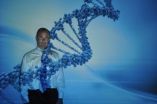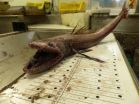(Press-News.org) PULLMAN, Wash.—Researchers at Washington State University have used a super-cold cloud of atoms that behaves like a single atom to see a phenomenon predicted 60 years ago and witnessed only once since.
The phenomenon takes place in the seemingly otherworldly realm of quantum physics and opens a new experimental path to potentially powerful quantum computing.
Working out of a lab in WSU's Webster Hall, physicist Peter Engels and his colleagues cooled about one million atoms of rubidium to 100 billionths of a degree above absolute zero. There was no colder place in the universe, said Engels, unless someone was doing a similar experiment elsewhere on Earth or on another planet.
At that point, the cluster of atoms formed a Bose-Einstein condensate - a rare physical state predicted by Albert Einstein and Indian theorist Satyendra Nath Bose - after undergoing a phase change similar to a gas becoming a liquid or a liquid becoming a solid. Once the atoms acted in unison, they could be induced to exhibit coherent "superradiant" behavior predicted by Princeton University physicist Robert Dicke in 1954.
"This large group of atoms does not behave like a bunch of balls in a bucket," said Engels. "It behaves as one big super-atom. Therefore it magnifies the effects of quantum mechanics."
Engels' findings appear in the journal Nature Communications. Co-author and collaborator Chuanwei Zhang, a former WSU physicist now at the University of Texas at Dallas, led the theoretical aspects of the work.
Funders include the National Science Foundation, the Army Research Office and the Defense Advanced Research Projects Agency, the cutting-edge research agency known as DARPA.
Researchers using these super-cold dilute gases have created the superradiant state in only one other situation, said Engels, using a far more complicated experiment involving coupling to photon fields. Because the coupling of atoms and photons is usually very weak, their behavior was extremely hard to observe, he said.
"What our colleague Chuanwei Zhang realized is, if you replaced the light with the motion of the particles, you got exactly the same physics," said Engels. Moreover, it's easier to observe. So while their cloud of atoms measures less than half a millimeter across, it is large enough to be photographed and measured. This gives experimenters a key tool for testing assumptions and changes in the atomic realm of quantum physics.
"We have found an implementation of the system that allows us to go in the lab and actually test the predictions of the Dicke model, and some extensions of it as well, in a system that is not nearly as complicated as people always thought it has to be for the Dicke physics," Engels said.
Ordinary physical properties change so dramatically in quantum mechanics that it can seem like a drawing by M.C. Escher. Photons can be both waves and particles. A particle can go through two spaces at the same time and, paradoxically, interfere with itself. Electrons can be oriented up or down at the same time.
This concurrent duality can be exploited by quantum computing. So where a conventional computer uses 1s and 0s to make calculations, the fundamental units of a quantum computer could be 1s and 0s at the same time. As Wired magazine recently noted, "It's a mind-bending, late-night-in-the-dorm-room concept that lets a quantum computer calculate at ridiculously fast speeds."
INFORMATION: END
WSU researchers confirm 60-year-old prediction of atomic behavior
Discovery opens new experimental path to superfast quantum computing
2014-06-04
ELSE PRESS RELEASES FROM THIS DATE:
New proactive approach unveiled to malware in networked computers and data
2014-06-04
Cybercrime comes in all forms these days. One recent headline told of the creepware or silent computer snooping that resulted in the arrest of some 90 people in 19 countries. Miss Teen USA was among the victims. Her computer had been turned into a camera and used to spy on her in her own bedroom.
On the commercial front, Target suffered the largest retail hack in U.S. history during the Christmas shopping season of 2013, and now the Fortune 500 company's outlook is bleak with steep drops in profits.
New research to be announced at the June 2014 ACM Symposium on Information, ...
Parasites fail to halt European bumblebee invasion of the UK
2014-06-04
A species of bee from Europe that has stronger resistance to parasite infections than native bumblebees has spread across the UK, according to new research at Royal Holloway, University of London.
The study, published today (Wednesday 4th June 2014) in the Journal of Animal Ecology, shows that tree bumblebees have rapidly spread despite them carrying high levels of an infection that normally prevents queen bees from producing colonies. The species arrived in the UK from continental Europe 13 years ago and has successfully spread at an average rate of nearly 4,500 square ...
Locked, loaded & feeling low: Dangers of gun ownership in the elderly
2014-06-04
In the United States the debate around gun ownership often focuses on teenagers; however, research shows that elderly Americans are the most likely to own a gun and that presents both medical and legal problems for physicians and carers.
Writing in the Journal of the American Geriatrics Society, Dr. Ellen Pinholt explores these issues and proposes a series of 'red flag' questions which caregivers must ask.
While there is no upper age limit on owning a firearm, Americans aged over 65 have the highest prevalence of dementia, depression and suicide. Federal law prohibits ...
Short intervals between pregnancies result in decreased pregnancy length
2014-06-04
Women who have short intervals between pregnancies of less than 18 months are more likely to see a decrease in the length of subsequent pregnancies, finds a new study published today (4 June) in BJOG: An International Journal of Obstetrics and Gynaecology.
The US study, using birth records from the Ohio Department of Health, looked at 454,716 live births from women with two or more pregnancies over a six year period. The researchers looked at the influence of inadequate birth spacing on the duration of the subsequent pregnancy.
The study defined short interpregnancy ...
Genes/adversity linked to crime in incarcerated sample
2014-06-04
HUNTSVILLE, TX (6/4/14) -- Researchers at Sam Houston State University have found a genetic characteristic that interacts with childhood adversity to predict higher rates of crime in an incarcerated sample.
The study is the first in a series that will examine contributions of genetic and environmental variations to criminal behavior. Published in Psychiatric Genetics, this study examines the role of monoamine oxidase A (MAOA), which has been linked to aggression, violence, and various types of childhood adversity in prior research. The study found MAOA genotype interacted ...
Count of new CFCs in the atmosphere rises from 4 to 7
2014-06-04
Scientists at the University of East Anglia have found two new chlorofluorocarbons (CFCs) and one new hydrochlorofluorocarbon (HCFC) in the atmosphere.
The research, published today in the journal Atmosphere, comes after another four man-made gases were discovered by the same team in March.
Scientists made the discovery by comparing today's air samples with air collected between 1978 and 2012 in unpolluted Tasmania, and samples taken during aircraft flights.
Measurements show that all but one of the new gases have been released into the atmosphere in recent years. ...
Astronomers discover ancient worlds from another galaxy next door
2014-06-04
An international team of scientists, led by astronomers at Queen Mary University of London, report of two new planets orbiting Kapteyn's star, one of the oldest stars found near the Sun. One of the newly-discovered planets could be ripe for life as it orbits at the right distance to the star to allow liquid water on its surface.
Discovered at the end of the 19th century and named after the Dutch astronomer who discovered it (Jacobus Kapteyn), Kapteyn's star is the second fastest moving star in the sky and belongs to the galactic halo, an extended cloud of stars orbiting ...
Iron, steel in hatcheries may distort magnetic 'map sense' of steelhead
2014-06-04
CORVALLIS, Ore. – Exposure to iron pipes and steel rebar, such as the materials found in most hatcheries, affects the navigation ability of young steelhead trout by altering the important magnetic "map sense" they need for migration, according to new research from Oregon State University.
The exposure to iron and steel distorts the magnetic field around the fish, affecting their ability to navigate, said Nathan Putman, who led the study while working as a postdoctoral researcher in the Department of Fisheries and Wildlife, part of OSU's College of Agricultural Sciences.
Just ...
Two planets orbit nearby ancient star
2014-06-04
Washington, D.C.— An international team of astronomers, including five Carnegie scientists, reports the discovery of two new planets orbiting a very old star that is near to our own Sun. One of these planets orbits the star at the right distance to allow liquid water to exist on its surface, a key ingredient to support life. Their work is published by Monthly Notices of the Royal Astronomical Society.
Kapteyn's Star, named after the Dutch astronomer, Jacobus Kapteyn, who discovered it at the end of the 19th century, is the second fastest-moving star in the sky and belongs ...
Deep sea fish remove 1 million tonnes of CO2 every year from UK and Irish waters
2014-06-04
Deep sea fishes remove and store more than one million tonnes of CO2 from UK and Irish surface waters every year, according to a new study led by the University of Southampton.
This natural carbon capture and storage scheme could store carbon equivalent to £10 million per year in carbon credits.
Fish living in deep waters on the continental slope around the UK play an important role carrying carbon from the surface to the seafloor.
It is assumed that deep water fishes all depend on particles that fall from the surface for their energy. These bottom-living deep water ...
LAST 30 PRESS RELEASES:
Numbers in our sights affect how we perceive space
SIMJ announces global collaborative book project in commemoration of its 75th anniversary
Air pollution exposure and birth weight
Obstructive sleep apnea risk and mental health conditions among older adults
How talking slows eye movements behind the wheel
The Ceramic Society of Japan’s Oxoate Ceramics Research Association launches new international book project
Heart-brain connection: international study reveals the role of the vagus nerve in keeping the heart young
Researchers identify Rb1 as a predictive biomarker for a new therapeutic strategy in some breast cancers
Survey reveals ethical gaps slowing AI adoption in pediatric surgery
Stimulant ADHD medications work differently than thought
AI overestimates how smart people are, according to HSE economists
HSE researchers create genome-wide map of quadruplexes
Scientists boost cell "powerhouses" to burn more calories
Automatic label checking: The missing step in making reliable medical AI
Low daily alcohol intake linked to 50% heightened mouth cancer risk in India
American Meteorological Society announces Rick Spinrad as 2026 President-Elect
Biomass-based carbon capture spotlighted in newly released global climate webinar recording
Illuminating invisible nano pollutants: advanced bioimaging tracks the full journey of emerging nanoscale contaminants in living systems
How does age affect recovery from spinal cord injury?
Novel AI tool offers prognosis for patients with head and neck cancer
Fathers’ microplastic exposure tied to their children’s metabolic problems
Research validates laboratory model for studying high-grade serous ovarian cancer
SIR 2026 delivers transformative breakthroughs in minimally invasive medicine to improve patient care
Stem Cell Reports most downloaded papers of 2025 highlight the breadth and impact of stem cell research
Oxford-led study estimates NHS spends around 3% of its primary and secondary care budget on the health impacts of heat and cold in England
A researcher’s long quest leads to a smart composite breakthrough
Urban wild bees act as “microbial sensors” of city health.
New study finds where you live affects recovery after a hip fracture
Forecasting the impact of fully automated vehicle adoption on US road traffic injuries
Alcohol-related hospitalizations from 2016 to 2022
[Press-News.org] WSU researchers confirm 60-year-old prediction of atomic behaviorDiscovery opens new experimental path to superfast quantum computing





